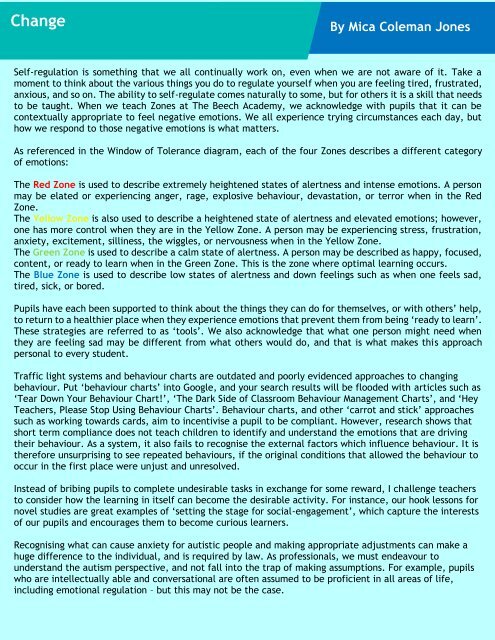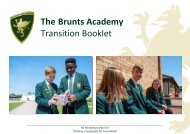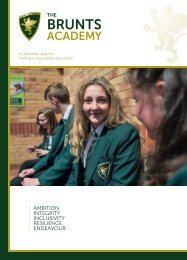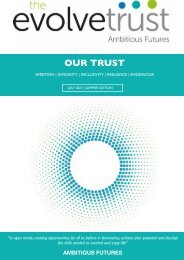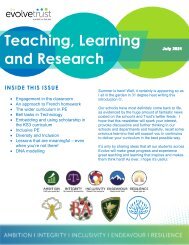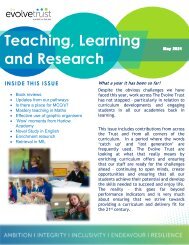Spring 1 2021 Teaching and Learning Newsletter
Teaching and learning newsletter - The Evolve Trust
Teaching and learning newsletter - The Evolve Trust
Create successful ePaper yourself
Turn your PDF publications into a flip-book with our unique Google optimized e-Paper software.
Change<br />
By Mica Coleman Jones<br />
Self-regulation is something that we all continually work on, even when we are not aware of it. Take a<br />
moment to think about the various things you do to regulate yourself when you are feeling tired, frustrated,<br />
anxious, <strong>and</strong> so on. The ability to self-regulate comes naturally to some, but for others it is a skill that needs<br />
to be taught. When we teach Zones at The Beech Academy, we acknowledge with pupils that it can be<br />
contextually appropriate to feel negative emotions. We all experience trying circumstances each day, but<br />
how we respond to those negative emotions is what matters.<br />
As referenced in the Window of Tolerance diagram, each of the four Zones describes a different category<br />
of emotions:<br />
The Red Zone is used to describe extremely heightened states of alertness <strong>and</strong> intense emotions. A person<br />
may be elated or experiencing anger, rage, explosive behaviour, devastation, or terror when in the Red<br />
Zone.<br />
The Yellow Zone is also used to describe a heightened state of alertness <strong>and</strong> elevated emotions; however,<br />
one has more control when they are in the Yellow Zone. A person may be experiencing stress, frustration,<br />
anxiety, excitement, silliness, the wiggles, or nervousness when in the Yellow Zone.<br />
The Green Zone is used to describe a calm state of alertness. A person may be described as happy, focused,<br />
content, or ready to learn when in the Green Zone. This is the zone where optimal learning occurs.<br />
The Blue Zone is used to describe low states of alertness <strong>and</strong> down feelings such as when one feels sad,<br />
tired, sick, or bored.<br />
Pupils have each been supported to think about the things they can do for themselves, or with others’ help,<br />
to return to a healthier place when they experience emotions that prevent them from being ‘ready to learn’.<br />
These strategies are referred to as ‘tools’. We also acknowledge that what one person might need when<br />
they are feeling sad may be different from what others would do, <strong>and</strong> that is what makes this approach<br />
personal to every student.<br />
Traffic light systems <strong>and</strong> behaviour charts are outdated <strong>and</strong> poorly evidenced approaches to changing<br />
behaviour. Put ‘behaviour charts’ into Google, <strong>and</strong> your search results will be flooded with articles such as<br />
‘Tear Down Your Behaviour Chart!’, ‘The Dark Side of Classroom Behaviour Management Charts’, <strong>and</strong> ‘Hey<br />
Teachers, Please Stop Using Behaviour Charts’. Behaviour charts, <strong>and</strong> other ‘carrot <strong>and</strong> stick’ approaches<br />
such as working towards cards, aim to incentivise a pupil to be compliant. However, research shows that<br />
short term compliance does not teach children to identify <strong>and</strong> underst<strong>and</strong> the emotions that are driving<br />
their behaviour. As a system, it also fails to recognise the external factors which influence behaviour. It is<br />
therefore unsurprising to see repeated behaviours, if the original conditions that allowed the behaviour to<br />
occur in the first place were unjust <strong>and</strong> unresolved.<br />
Instead of bribing pupils to complete undesirable tasks in exchange for some reward, I challenge teachers<br />
to consider how the learning in itself can become the desirable activity. For instance, our hook lessons for<br />
novel studies are great examples of ‘setting the stage for social-engagement’, which capture the interests<br />
of our pupils <strong>and</strong> encourages them to become curious learners.<br />
Recognising what can cause anxiety for autistic people <strong>and</strong> making appropriate adjustments can make a<br />
huge difference to the individual, <strong>and</strong> is required by law. As professionals, we must endeavour to<br />
underst<strong>and</strong> the autism perspective, <strong>and</strong> not fall into the trap of making assumptions. For example, pupils<br />
who are intellectually able <strong>and</strong> conversational are often assumed to be proficient in all areas of life,<br />
including emotional regulation – but this may not be the case.


